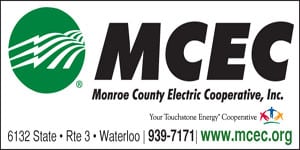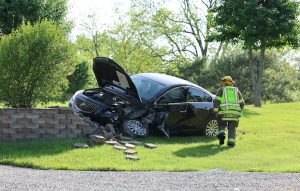Proposed formula would spell disaster for area schools
The minutia behind passing legislation can escape a person if they turn to such learning guides as School House Rock’s “I’m just a bill.”
Yes, the bill does spend a lot of time “sitting here on Capitol Hill.” But a lot of debate and deliberation takes place during Congress’ open session regarding the different legislation.
For instance, Illinois Senate Bill 231, also known as the “Better Funding for Better Schools Act,” has seen a lot of attention from the media and a lot of debate inside the Illinois Senate and House.
The proposed funding formula change would bring about losses of thousands or even millions of dollars in state funding for many area schools. This is because SB 231 creates a formula that attempts to distribute general state aid in a more equitable manner.
The bill passed through the state senate May 10. State Sen. David Luechtefeld (R-Okawville) voted “present” on the bill.
As of now, SB 231 is in the House with a first reading completed and a deadline of this Friday as the last day to vote on the bill.
Equitable funding is meant to meet school districts where they’re at. For example, a school district with a larger number of special needs students than normal may receive $6 million with another district only receiving $4 million from the state.
This difference is considered equitable funding from the perspective that the district receiving $6 million needs more funding to give the same quality education as the school receiving $4 million.
Other factors besides special needs programs influence equitable funding, such as a higher poverty rate in the district’s townships or additional funding needed for an English language learners program.
Therefore, districts in communities with lower poverty rates and such would likely receive less aid. These districts would need to rely more on local revenue to pay for their students’ education expenses.
An example is with Columbia and the community’s 13 percent poverty rate. In this case, Columbia loses about $1.25 million with SB 231 partly because of this low poverty rate.
Columbia school superintendent Dr. Gina Segobiano went no further than to say at Thursday’s school board meeting that the district would in that case lose 40 percent of general state aid.
“There have been many funding proposals in the past that have never reached fruition,” Segobiano said to the Republic-Times. “So, I hesitate to overreact until I know the certainty of the new school funding bill and how the state plans on funding.”
Right now, the Waterloo school district’s local revenue accounts for 76 percent of overall revenues. The remaining 24 percent comes from the state.
Waterloo schools would lose as much as $1.6 million in state aid and would need an estimated 86 percent of revenues to be local under SB 231.
“(That much loss) would be devastating to us,” Waterloo school superintendent Brian Charron said.
Charron painted a picture of what the passage of SB 231 would mean for the district at the last school board meeting that includes reductions in force totalling 20 to 25 teachers along with the abolishment of extracurricular programs. Valmeyer would lose more than $220,000 under SB 231.
Other districts outside of Monroe County would come out losing as well. In fact, Red Bud School District would lose as much as $627,000 and O’Fallon School District would lose close to $1.2 million.
“I don’t know how we come with fully funding state aid and have that significant (of losses),” Kelton Davis, Monroe-Randolph Regional Office of Education Superintendent, said of the proposed formula.
Districts that would gain are also nearby. Both Belleville and Dupo school districts would see an increase — more than $430,000 for Dupo and about $1.1 million for Belleville.
Even without this possible formula, Illinois school districts began seeing a drop in state aid as early as 2009. Charron said the way state aid has declined through the years is troubling.
“I would like to see the state fund the current formula and then say it’s not working,” he said.
To elaborate, the state is reportedly only funding up to 92.1 percent of the general state aid claim for fiscal year 2016.
A general state aid overview for the current fiscal year set up by the Illinois State Board of Education shows Waterloo receiving about $299,000 less than the net general state aid claim for the district.
Columbia loses around $214,000 and the district so far only received three of four special education and transportation payments from the state. Valmeyer loses as much as $73,000.
In March, the village passed a referendum to give Valmeyer schools an additional $300,000 working cash per year for the next five years to make up for the state funding woes.
Many of the school districts in Davis’ region are facing budget cuts in transportation, and at least one school district cannot even transport kids to athletic competitions.
“We do believe in wholistic education for our children, but we can’t afford it right now,” Davis said.
He added there is no formula that can make every district in the state a winner because the state is funneling the same money through different methods. In other words, the state needs to add more money to the pot for school funding to work.
Under one of the amendments made on the bill, a “Hold Harmless State Funding” provision was created to prevent any school district from losing money in the first year the bill would go into effect. Losing school districts would start to see a decline in aid the year after that and the numbers would keep dropping.
However, Davis said these losers would really need for the hold harmless provision to last three to five years.
“We as a board and a community can deal with issues in declining revenue, but we need to be able to plan for it,” he said.
Governor Bruce Rauner will likely veto the bill if it gets to his desk. However, many are skeptical the House will allow the funding formula change to gain that much momentum.
“What I do think is going to be a reality is there will not be agreement on a (state budget), which means a lack of state aid,” Charron said.
Without a projection of what school districts would receive for the next fiscal year in aid, they cannot plan how much is needed in property tax revenue.
State aid and tax revenue combine to provide full funding for student education. Meanwhile, property taxes account for much more of revenue than state aid.
Columbia, for example, only relies on state aid for 20 percent of its school district budget.
The budget impasse is nearing the 12-month mark and Democrats and Republicans continue to debate the logistics of a 2017 fiscal year budget.
“We have a systemic issue that needs to be dealt with,” Davis said.
Right now, the last day planned for the Illinois General Assembly to be in session is May 31.
Rauner announced that he might pay for a special session out of his own pocket if the assembly cannot come to a conclusion on the budget before that deadline.








